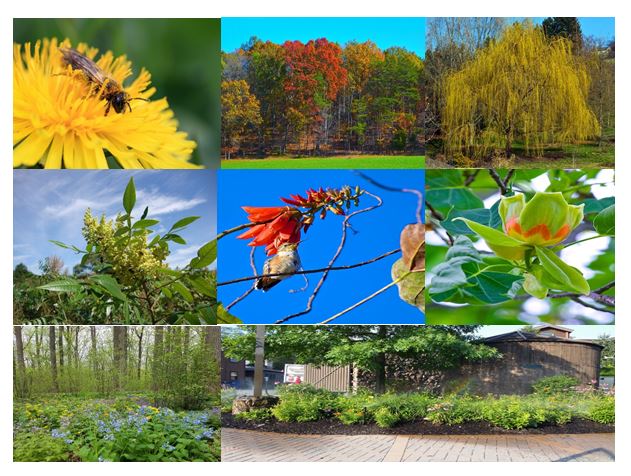Ecologists and biologists compared data of about 1,500 agricultural fields around the world: from corn fields in the American plains to oilseed rape fields in southern Sweden, to coffee plantations in India, mango plantations in South Africa and cereal crops in the Alps. They analyzed two ecosystem services (i.e., processes regulated by nature that are beneficial and free for humans): the pollination service provided by wild insects and biological pest control service, which is the ability of an environment to use predatory arthropods present in the ecosystem to defend itself from harmful insects.
In heterogeneous landscapes — where the variation of crops, hedges, trees and meadows is greater — wild pollinators and “beneficial” insects are more abundant and diversified. Not only do pollination and biological control increase, so does the crop yield. On the other hand, monocultures are the cause of roughly a third of the negative effects on pollination that result from landscape simplification (measured by loss of ‘pollinator richness’). This effect is even greater with the control of harmful insects, where loss of ‘natural enemy richness’ represents 50 per cent of the total consequences of landscape simplification.
“Our study shows that biodiversity is essential to ensure the provision of ecosystem services and to maintain a high and stable agricultural production,” explains Matteo Dainese, a biologist at Eurac Research and first author of the study. “For example, a farmer can depend less on pesticides to get rid of harmful insects if natural biological controls are increased through higher agricultural biodiversity.” The researchers recommend to protect environments whose health is maintained through biodiversity and to diversify crops and landscapes as much as possible.
“Under future conditions with ongoing global change and more frequent extreme climate events, the value of farmland biodiversity ensuring resilience against environmental disturbances will become even more important,” underlines animal ecologist Ingolf Steffan-Dewenter from the Department of Animal Ecology and Tropical Biology at the University of Würzburg, the initiator of the study within the EU project ‘Liberation’. “Our study provides strong empirical support for the potential benefits of new pathways to sustainable agriculture that aim to reconcile the protection of biodiversity and the production of food for increasing human populations.”
______________________________________________________________________________________________________________________________________
Operation Trees for Bees: Plant Trees This Fall to Stem Climate Change & Pollinator Decline
Xerces Society
Most bees and other pollinator species are under stress, and while we wish could prescribe them some Prozac, the better action would be reducing as many of their stressors as possible. According to a United Nations study released in 2016, stressors include: fragmented habitat, poor nutrition, pesticides, diseases, parasites, and climate change, which are interacting to put 40% of insect pollinators at risk of extinction.
Honey bee and bumble bee enjoying sumac blooms. Sumac trees are great for ornamental landscapes since they don’t grow to more than 30 feet and they have gorgeous red fall color. Photo: Kelly Gill / Xerces Society
Pollinators Need Trees!
What if I told you just by planting a tree in an urban or suburban area, you could help lots of species of pollinators and birds, filter stormwater runoff before it pollutes and floods streams, reduce the urban heat island effect, and mitigate climate change? This is actually a case of too good not to be true! Almost all bees, butterflies, moths, wasps, flies, beetles, birds and bat pollinators would benefit tremendously from more native and/or blooming trees—veritable meadows in the sky. America’s nearly 3600 species of native bees rely on pollen from flowers as their primary source of protein and nectar for their carbohydrates. About one third of bee species specialize on specific plants families for their pollen source, many of them native trees. Many butterflies and moths lay their eggs in native trees, where their caterpillars feast on the leaves. According to Dr. Doug Tallamy, author of Bringing Nature Home, native oaks (Quercus spp.) support 534 species of butterflies and moths, black cherries (Prunus spp.)–456, and willows (Salix spp.)–455. Many pollinator species nest or overwinter in leaf litter from trees, or in dead wood in small tunnels made by beetles and other critters.
Our Planet Needs Trees!
A recent study by the Intergovernmental Panel on Climate Change (IPCC) showed that forest restoration offers one of the best climate cooling solutions available today. You can read the report here.
For substantial impact, researchers found we would need to plant at least 1 trillion trees as soon as possible to allow them to begin sequestering carbon and restore forest ecosystems. Through the miracle of photosynthesis, healthy trees take carbon dioxide out of the atmosphere and store it in their leaves, trunks, branches and roots until they die.
While the IPCC study prioritized restoring forests, its central finding of the power of trees to store carbon and cool the planet serves as a good recommendation for urban areas as well. Equally important, those same trees offer hope for reversing some pollinator declines.
What Are You Waiting For? Get Buzzy!
Step 1:
Gather a group of stakeholders who care about both pollinators and climate change to brainstorm what it would take to get lots of trees (preferably native or fruit trees) in the ground this fall and spring. Consider inviting your local Bee City USA or Bee Campus USA committee, tree nurseries and retailers, Audubon Society, Sierra Club, tree board, native plant society, beautification committees, civic groups and Master Gardeners. There are 3 goals for this planning meeting: a) Set a time and place for a public meeting; b) Brainstorm a list of local native tree suppliers; and, c) Determine who will quickly survey those suppliers to develop a recommended list of native trees including whether they are available this fall or next spring.
CAUTION FOR FALL TREE PLANTING
Dug, balled and burlapped trees are considered fall transplant hazards, including many natives. Containers should be safer as long as they are planted well, with roots spread out and in good contact with the native soil. Read more here.
Step 2:
Identify the meeting facilitator and promote the meeting–invite your email lists and run a guest editorial or ad in local media for a few weeks to announce the public meeting to recruit tree planters.
Step 3:
At the public meeting, share the recommended species list and suppliers, explain the goals for “Operation Trees for Bees,” and ask how many trees they think their community could plant within 12 months. With that target in mind, ask who will buy the trees, who will plant them and where? Identify stream banks that could use more trees and shrubs for stabilization and, in turn, serve as welcoming habitat corridors for pollinators. (Friendly competition among organizations or neighborhoods can be a good motivator!) Realizing that trees must be tended if they are to grow up and sequester lots of carbon, perhaps each stakeholder group could commit to a certain number of trees they feel is realistic for them. Trees could be bought in bulk and resold, or individuals could buy their own tree from a retailer. To sustain enthusiasm and recognize those who are planting trees, ask someone to set up a website or Facebook page to track progress. It would be great to have a very public “thermometer sign” somewhere in town to track progress as well. An artist could have lots of fun with the sign!
Commercial parking lots like this one in Medford, New Jersey, can host pollinator gardens that include trees! Photo: Kelly Gill / Xerces Society
Step 4:
Implement the plan and host a celebration at the end of the year for all of the tree planters to attend with a photo and name of the tree they planted hanging from their neck. At that meeting, gather commitments for trees to be planted in 2020, especially during April, which is both Earth Day and Arbor Day month.
RESOURCES:
- Native Trees Spreadsheet–Nearly comprehensive Excel spreadsheet of trees native to the United States with columns for pollinator usage; salt, drought and fire tolerance; browsing/grazing risk; and commercial availability. The “workhorse” column refers to trees known to establish well, that are readily used by revegetation experts. They receive a “workhorse/pollinator” designation if they are “workhorses” AND support pollinators. This data is a portion of a national native plant database for restoration practitioners (http://www.nativerevegetation.org/era/) that Xerces contributed pollinator data to, as part of a project with FHWA, USFS, and others.
- Xerces Blog: Climate News Round-Up: The Power of Trees!
- 100 Plants to Feed the Bees
- Heather Holm’s Tree & Shrub List
- Pollen Sources
- Nectar Sources
- USDA National Agroforestry Center Wildlife & Pollinator Resources









